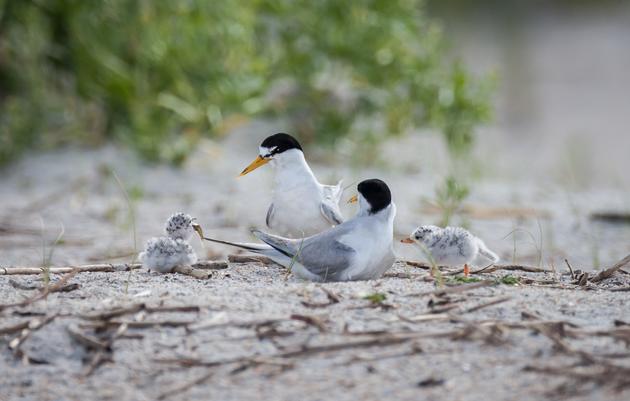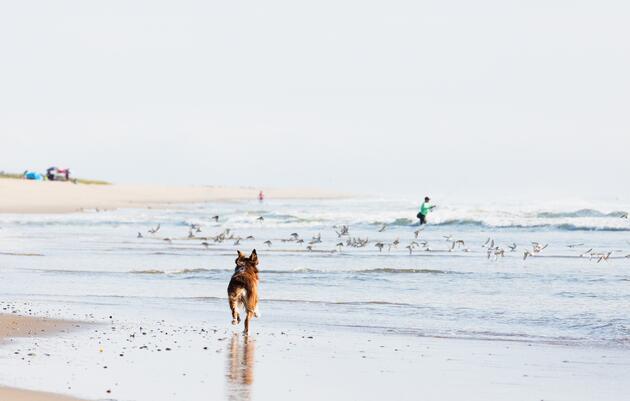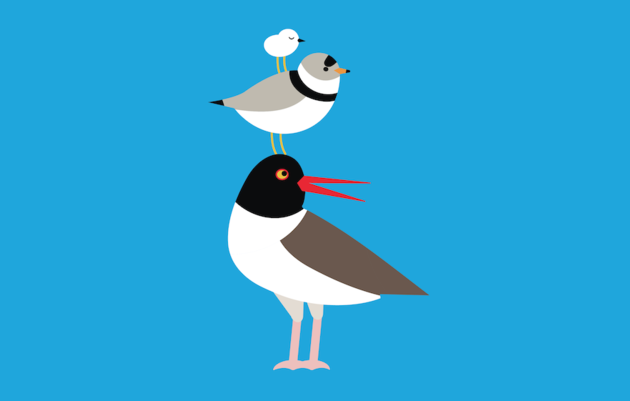Photography of shorebirds and seabirds along Connecticut’s coasts is a popular recreational activity, but it's important to follow certain steps to avoid endangering the birds. Many shorebird populations are in decline, due in part to human activity. Direct impact from photographers occurs every year, causing nest failures and deaths of chicks and possibly adults. The safest thing to do is to avoid photographing endangered species during the nesting season.
Here are guidelines on how to attempt to safely photograph shorebirds without disturbing them.
During Nesting Season (March through September)
During the breeding and nesting season, many shorebird nesting areas are posted or staked off with signs and string*. This gives the birds space to nest without disturbance from people, so long as beachgoers respect the fencing and do not enter.
The Audubon Alliance for Coastal Waterbirds needs your help to ensure these posted areas do not draw excessive attention or prolonged disturbance to nesting birds.
*If you find a nest that is not posted or is outside of a fenced-off area, please notify CT DEEP, Audubon Alliance staff, or an official volunteer as soon as possible.
Things to know when photographing a bird on a nest:
- String fencing is erected as an absolute bare minimum boundary to appease the public, municipalities, land owners, or other entities. This means that approaching the fence is often far too close for our birds. Obviously you should not enter the posted area, but you should also remain far enough away to avoid disturbing the birds (ideally 50 meters or more). If the birds show any sign of agitation as a result of your presence, quietly and slowly retreat until the birds no longer appear disturbed.
- Sometimes birds will nest near the edge of a posted boundary--so even if you are outside the string, if the bird responds to you, you’re too close! We advise never getting close enough to cause the bird to leave its nest. Please back off immediately if you "flush" a bird, or cause it to fly off of its nest.
- Predators that pose a threat to birds, eggs, and chicks can be attracted to the nesting area by human presence or scent. Before approaching a nesting area, scan for raccoons, cats, or crows. These predators also are alert to movement, so by flushing a bird, you may inadvertently help predators notice birds that would otherwise have remained camouflaged.
- Humans that overstay their welcome may unduly stress the birds. Be considerate and do not spend more than 10 minutes near the nest. If other photographers are present, try to coordinate your time near the nest, and leave the area together to maximize the amount of undisturbed time the birds have.
- Advertising nesting activity may draw additional disturbance to the nest and chicks. Please refrain from sharing or publishing chick photos during the nesting season. If you do share, consider including messaging to educate others on how to #ShareTheShore!
Things to know when photographing birds that are away from the nest, or birds with chicks:
- Patience is a virtue! While we do suggest staying at least 50 meters/164 ft away from the birds when possible, as they forage and explore, they may naturally get close enough for you to get that perfect shot.
- The birds will make many trips from their nest to the shoreline while foraging for food. In order to give them a safe passageway to feed and rest, do not “push” the birds around the beach. Shorebird chicks, especially, must constantly forage to gain enough weight to fledge in time, so any time taken away from foraging can be harmful to their health and survival.
During Migration Season (May/July through October)
Even outside of the nesting season, disturbance can be harmful to shorebirds. Each time a bird is disturbed and forced to fly off while it is feeding or resting, it uses important energy reserves needed for survival, migration, and future breeding. Due to the widespread decline of shorebird populations, it is especially important to let the birds feed and rest without causing disturbance that could pose additional threats to their survival. Therefore, many of the same guidelines listed above apply.
- Remember to never push birds around the beach. Stay far enough away so the birds do not change their behavior in response to your presence.
- Report banded birds. If you photograph a bird with plastic or metal leg bands, please report band colors & codes to www.bandedbirds.org or to amoywg.org.
Advocate for the birds!
Wildlife photographers can be important advocates for birds, if they follow these simple guidelines and help educate their peers on the beach. However, if you observe someone disturbing shorebirds, and they do not respond to a polite request to stop, please immediately notify the Audubon Alliance for Coastal Waterbirds via ctwaterbirds@gmail.com. In more extreme cases, contact the CT ENCON Police: Hotline at 1-860-424-3333.






